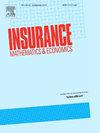多元最优风险转移中的分散效应
IF 2.2
2区 经济学
Q2 ECONOMICS
引用次数: 0
摘要
在多变量风险转移的背景下,有两个主要的实际问题。首先,非集团内部风险转移提出了一个问题,即是为总体风险购买(再)保险,还是为每个风险单独购买保险。其次,集团内部风险转移总是受到监管机构的质疑,即此类交易是否存在商业目的,因此,保险购买者必须在商业上验证他们的决定。本文分别从买方和卖方的角度对多元化效应进行了研究。我们对保险购买者的分析是基于总损失的最佳再保险风险边际成本与每种损失类型的个人最佳风险边际成本之和之间的比率。由于分析比较是不可行的,我们开发了一种统计推断方法,并通过模拟评估其有限样本性能。卖方的观点是通过一种新的方法来评估提供联合风险转移合同与单独风险转移合同的相对盈利能力。这些措施的综合使用使买卖双方能够确定对双方都具有商业可行性的最佳风险转移决策。最后,我们将提出的推理方法应用于广泛研究的丹麦火灾损失数据集,说明我们的研究结果同样适用于群体内或非群体内风险转移的实际意义。本文章由计算机程序翻译,如有差异,请以英文原文为准。
Diversification effect in multivariate optimal risk transfer
There are two main practical questions in the context of multivariate risk transfers. First, non-intragroup risk transfers raise the question of whether to purchase (re)insurance coverage for the aggregate risk or separately for each risk. Second, intragroup risk transfers are always challenged by regulators on whether there is a commercial purpose in such transactions, and therefore, insurance buyers must commercially validate their decisions. This paper investigates the diversification effect from the buyer's and the seller's perspectives. Our analysis for insurance buyers is based on the ratio between the optimal reinsurance risk margin cost for the total sum of losses and the sum of the individual optimal risk margin costs for each loss type. Because analytical comparison is infeasible, we develop a statistical inference method for this ratio and evaluate its finite sample performance through simulation. The seller's perspective is modeled via a new measure to assess the relative profitability of offering joint versus separate risk transfer contracts. The combined use of these measures enables both buyers and sellers to identify optimal risk transfer decisions that are commercially viable for both parties. Finally, we apply the proposed inference methods to the widely studied Danish fire loss dataset, illustrating the practical implications of our findings that equally apply to an intragroup or non-intragroup risk transfer.
求助全文
通过发布文献求助,成功后即可免费获取论文全文。
去求助
来源期刊

Insurance Mathematics & Economics
管理科学-数学跨学科应用
CiteScore
3.40
自引率
15.80%
发文量
90
审稿时长
17.3 weeks
期刊介绍:
Insurance: Mathematics and Economics publishes leading research spanning all fields of actuarial science research. It appears six times per year and is the largest journal in actuarial science research around the world.
Insurance: Mathematics and Economics is an international academic journal that aims to strengthen the communication between individuals and groups who develop and apply research results in actuarial science. The journal feels a particular obligation to facilitate closer cooperation between those who conduct research in insurance mathematics and quantitative insurance economics, and practicing actuaries who are interested in the implementation of the results. To this purpose, Insurance: Mathematics and Economics publishes high-quality articles of broad international interest, concerned with either the theory of insurance mathematics and quantitative insurance economics or the inventive application of it, including empirical or experimental results. Articles that combine several of these aspects are particularly considered.
 求助内容:
求助内容: 应助结果提醒方式:
应助结果提醒方式:


